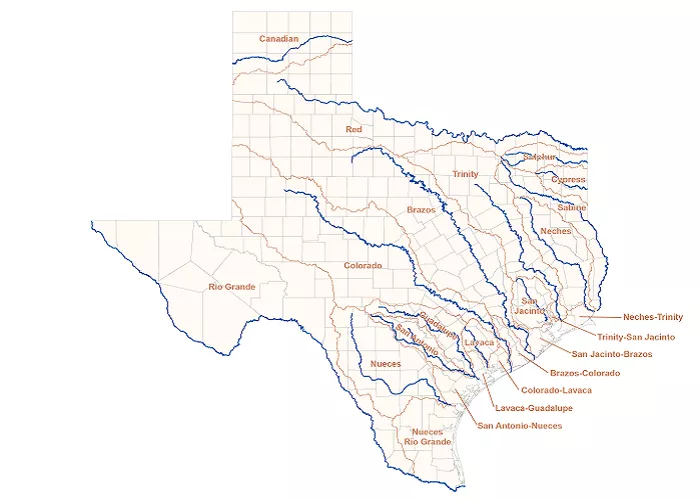Texas is home to many rivers, each with unique characteristics. Some are long, some are wide, and some are deep. But which one is the deepest river in Texas?
In this article, we will explore:
- Geographical Location – Where the deepest river flows
- Depth & Measurements – How deep it really is
- Cultural Significance – Its role in Texas history
- Economic Impact – How it supports industries
- Ecological Importance – Wildlife and conservation efforts
By the end, you’ll know which river holds the title of deepest in Texas and why it matters.
Geographical Location
Texas has 15 major rivers, but the Trinity River is often considered the deepest.
Key Facts About the Trinity River
- Length: 710 miles (longest river entirely within Texas)
- Basin Size: Covers 17,969 square miles
- Route: Flows from North Texas to the Gulf of Mexico
- Major Cities Along It: Dallas, Fort Worth, Houston
Other Deep Texas Rivers
| River | Max Depth (ft) | Region |
|---|---|---|
| Trinity | 60+ | North to Southeast |
| Brazos | 50+ | Central to Gulf |
| Rio Grande | 40+ | West Texas |
| Neches | 35+ | East Texas |
Why the Trinity?
- Its depth varies, but near Liberty, TX, it reaches 60+ feet deep.
- It has wide, slow-moving channels, allowing sediment to build up over time.
Depth & Measurements: How Deep Is It Really?
How River Depth Is Measured
- Sonar technology maps riverbeds.
- USGS (U.S. Geological Survey) tracks water levels.
Trinity River’s Deepest Points
- Near Liberty, TX – Up to 60 feet deep in some areas.
- Dallas Floodway – Around 30-40 feet deep.
- Houston Ship Channel – Dredged to 45 feet for ships.
Why Does Depth Change?
- Dams & reservoirs (like Lake Livingston) control flow.
- Dredging (digging out sediment) keeps shipping lanes open.
Comparison to Other Rivers
- Brazos River: ~50 feet near Waco.
- Rio Grande: ~40 feet in Big Bend canyons.
- Sabine River: ~35 feet near the Louisiana border.
Conclusion: The Trinity River is the deepest, especially near Liberty.
Cultural Significance: History & Legends
The Trinity River has shaped Texas history in many ways.
Native American Heritage
- Caddo and Wichita tribes lived along its banks.
- Used for fishing, trade, and transportation.
European Settlement
- Spanish explorers mapped it in the 1700s.
- Early Texan settlers used it for farming and travel.
Modern Cultural Impact
- Dallas & Fort Worth grew because of the river.
- Annual events like the Trinity River Audubon Bird Fest.
Fun Fact: Some say ghost ships from the 1800s still appear in foggy conditions!
Economic Impact: How the River Supports Texas
The Trinity River is vital for trade, water supply, and tourism.
1. Shipping & Trade
- Houston Ship Channel connects to the Gulf of Mexico.
- Moves oil, grain, and chemicals worldwide.
2. Agriculture & Water Supply
- Irrigation for farms in East Texas.
- Dallas-Fort Worth relies on it for drinking water.
3. Tourism & Recreation
- Kayaking, fishing, and hiking trails.
- Trinity River Vision Project (Fort Worth’s waterfront development).
Economic Value: Billions in trade and jobs each year.
Ecological Importance: Wildlife & Conservation
The Trinity River is home to diverse ecosystems.
Wildlife Along the River
- Fish: Catfish, bass, alligator gar.
- Birds: Bald eagles, herons, migratory ducks.
- Mammals: River otters, beavers.
Environmental Challenges
- Pollution from urban runoff.
- Invasive species like hydrilla (a fast-growing water plant).
Conservation Efforts
- Trinity River Audubon Center protects wetlands.
- Clean-up programs by local governments.
Why It Matters: A healthy river supports fishing, tourism, and clean water.
Conclusion
In summary, Trinity River is not only the deepest river in Texas but also one of the most significant in terms of its geographical, cultural, economic, and ecological contributions. Its depth, historical importance, and role in sustaining life along its course make it a vital natural resource for the state and the nation. Understanding and preserving the Rio Grande is essential for maintaining the balance between human development and environmental conservation in the region.

